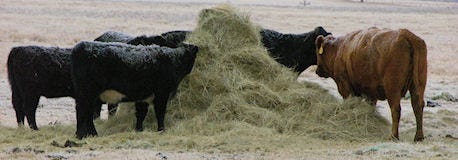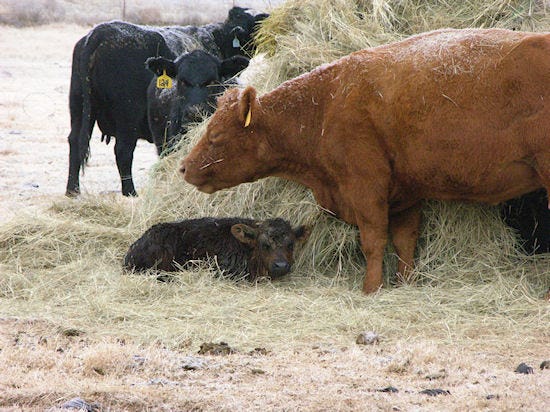August 1, 2012

As the drought expands and drains pasture production, many beef producers will need more hay than normal to get whatever livestock they still have through the winter.
"Like never before producers should consider methods to improve efficiency of harvested forage use," says Dave Lalman, Oklahoma State University beef extension specialist.
Lalman says three relatively simple concepts can help stretch hay. When combined these strategies could cut the need for hay by at least one third.
Limit feeding

Combination of limit feeding, ionophores and cone-type hay rings might cut hay use by one-third or more.
Feedyards and backgrounding operations have taken advantage of improved efficiencies associated with limit feeding growing cattle for many years. This strategy may also be used to substantially reduce hay use in cow/calf operations, Lalman says.
If you limit forage intake, forage digestibility should increase and waste should go down, he says.
Minnesota and Illinois researchers limited the amount of time cows had access to hay. When cows were allowed access to hay for six hours, hay intake was reduced by an average of 22% over three experiments. Hay waste was reduced with restricted access in two of the three experiments.
Cows with restricted access gained weight in all three of the experiments, even though they did not gain as much as cows with free-choice hay access. Lalman says this suggests that initial cow body condition and hay quality may be important factors for success if you choose to implement this strategy.
If cows are in poor body condition initially or if hay quality is extremely low, cow performance likely will suffer, as will newborn calf health and cow reproductive efficiency.

Good hay rings reduce waste--sheeted-bottom feeders are more expensive, but could make up the difference in hay savings.
Estimating free-choice intake and determining the degree of restriction below free-choice intake are critical factors in using the limit feeding strategy, Lalman says. The National Research Council publishes equations to estimate forage intake and these equations are incorporated into many cow/calf nutrition evaluation software programs.
The OSU Cowculator uses cow size, stage of production, milk yield and forage quality to estimate dry matter intake. Cowculator and many other nutrition evaluation programs can also be used to estimate performance of cows with varying degrees of hay restriction. Limit feeding is not recommended for first-calf heifers or thin, older cows.
Use good hay rings
OSU recently studied the effects of hay feeder design on hay waste and found significant savings could be had, Lalman says. In fact, the savings could more than pay for the higher cost of the better feeders.
The researchers evaluated two feeders with open-bottom rings and two feeders with sheeted bottom rings. The open-bottom feeders wasted an average of 21% of the original bale weight. These two feeders are light weight, convenient to use and inexpensive, and are the most popular feeder style in Oklahoma.
The sheeted-bottom feeder reduced hay waste to 13%. Even better, a modified cone feeder with a sheeted bottom reduced hay waste to only 5%. The feeders with sheeted bottoms are both heavier and more expensive than the open bottom feeders.
Nevertheless, assuming hay is priced at $120 per ton, over a 120-day feeding period the difference in the value of one feeding season's hay waste between the open-bottom steel ring feeder and the modified cone feeder is $468.72. Few cow/calf operations will be able to absorb the cost of 21% hay waste when hay is as costly as it is this year.
Use an ionophore
Feeding an ionophore for cattle on forage can increase the energy value of a forage diet and thus further reduce the need for hay, Lalman says. Older research has shown Rumensin and Bovatec improve weight gain of growing cattle. Rumensin is approved for the use in mature beef cows. Other research from the early 1980s showed that Rumensin reduced hay intake by around 10% while still producing about the same amount of weight gain.
Lalman says in a recent experiment at OSU cows fed 200 mg of Rumensin gained an additional half pound per head per day and nearly one half a body condition score more than cows without Rumensin in their diets during a 58-day study. In this project the forage digestibility was improved dramatically, resulting in the improved cow performance.
"One could look at the addition of Rumensin in the supplement as having increased the net energy value of low-quality hay diet by about 15%," he says. "In other words, less of the same diet would need to be fed to get the same performance."
"In our region, the cost of Rumensin is about 2 cents per cow per day. I don't know any other way to get that much improvement in forage utilization at such a low cost," Lalman adds.
There is no research on the combined savings when two or more of these technologies are combined, Lalman says. But he thinks it likely hay use could be reduced by 30% to 40% when two or all three of these strategies are used together.
You May Also Like




